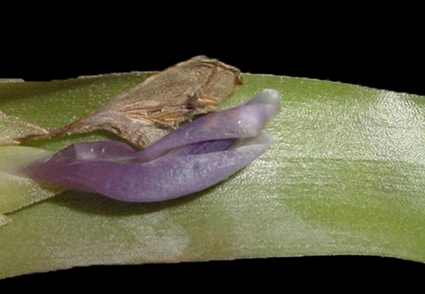Abstract
A species of Tillandsia, Tillandsia ramon-lopezii, from northern Venezuela, is proposed as new. The new taxon belongs in a group of species that are morphologically similar to T. brachycaulos but whose relationships require clarification. A full description, relevant iconography, including scanning electron microscope (SEM) images of peltate foliar and floral bract scales, and a discussion of affinities are provided. The conservation status of the new species was assessed using the IUCN Red List Criteria as LC.
References
- Bachman, S., Moat, J., Hill, A.W., de la Torre, J. & Scott, B. (2011) Supporting Red List threat assessments with GeoCAT: geospatial conservation assessment tool. ZooKeys 150: 117–126. https://doi.org/10.3897/zookeys.150.2109
- Baker, J.G. (1888) A synopsis of Tillandsieae. Journal of Botany, British and Foreign 26: 137–144.
- Butcher, D. (2012) Tillandsia brachycaulos/capitata complex. [https://fcbs.org/articles/t_brachycaulos_capitata_Complex.htm]
- Ehlers, R. (1994) Tillandsia velutina, a New Species from Mexico and Guatemala. Journal of the Bromeliad Society 44 (4): 153–155.
- Ehlers, R. (2015) Tillandsia riohondoensis—a new species within the relationship of Tillandsia capitata. Die Bromelie 2015 (2): 57–61.
- Ehlers, R. & Koide, P. (1994) Tillandsia rhodocephala; a New Species from Oaxaca, Mexico. Journal of the Bromeliad Society 44 (3): 130–133.
- Funk, V.A., Berry, P.E., Alexander, S., Hollowell, T.H. & Kelloff, C.L. (2007) Checklist of the Plants of the Guiana Shield (Venezuela: Amazonas, Bolivar, Delta Amacuro; Guyana, Surinam, French Guiana). Contributions from the United States National Herbarium 55: 1–584.
- Gardner, S. (1986) Preliminary classification of Tillandsia based on floral characters. Selbyana 9: 130–146.
- Granados-Mendoza, C., Granados-Aguilar, X., Donadío, S., Salazar, G.A., Flores-Cruz, M.E., Hágsater Starr, J.R., Ibarra-Manríquez, G., Fragoso-Martínez, I. & Magallón, S. (2017) Geographic structure in two highly diverse lineages of Tillandsia (Bromeliaceae). Botany 95: 641–651. https://doi.org/10.1139/cjb-2016-0250
- Grisebach, A.H.R. (1866) Catalogus plantarum cubensium. Leipzig, 301 pp.
- Hokche, O., Berry, P.E. & Huber, O. (Eds.) (2008) Nuevo Cat. Fl. Vasc. Venez. Fundación Instituto Botánico de Venezuela, Caracas, pp. 1–859.
- Holst, B.K. (1994) Checklist of Venezuelan Bromeliaceae with notes on species distribution by state and levels of endemism. Selbyana 15: 132–149.
- Holst, B.K. (1997) Bromeliaceae. In: Steyermark, J.A., Berry, P.E. & Holst, B.K. (Eds.) Flora of the Venezuelan Guayana. Vol. 3. Missouri Botanical Garden Press, St. Louis, pp. 549–676.
- Huber, O. & Alarcón, C. (1988) Mapa de vegetación de Venezuela 1:2.000.000. The Nature Conservancy, MARNR, Oscar Todtmann Editores: Caracas.
- Isley, P.T. (1987) Tillandsia: The World’s Most Unusual Airplants. Botanical Press. Gardena, California, 256 pp.
- IUCN [International Union for Conservation Nature] Standards and Petitions Committee (2022) Guidelines for Using the IUCN Red List Categories and Criteria. Version 15.1. Prepared by the Standards and Petitions Committee. Available from: https://www.iucnredlist.org/documents/RedListGuidelines.pdf (accessed 25 May 2022)
- Mondragón, D. & Barredo, F. (1999) Trichomes- an under- utilized taxonomic tool. Journal of the Bromeliad Society 25: 50–52. https://doi.org/10.1007/BF02889836
- Morren, C. (1836) Tillandsie nouvelle du Mexique. L’Horticulteur Belge 3: 251–253.
- Pinzón, J.P., Ramírez-Morillo, I., Carnevali, G., Barfuss, M.H., Till, W., Tun, J. & Ortiz, J.J. (2016) Phylogenetics and evolution of the Tillandsia utriculata complex (Bromeliaceae, Tillandsioideae) inferred from three plastid DNA markers and the ETS of the nuclear ribosomal DNA. Botanical Journal of the Linnean Society 181 (3): 362–390. https://doi.org/10.1111/boj.12425
- QGIS.org (2023) QGIS Geographic Information System. Open Source Geospatial Foundation Project. [https://qgis.org/]
- Ramírez, I. & Carnevali, G. (1994) Note: New records for Venezuela. Selbyana 15 (2): 85–86.
- Ramírez, M.I.M. & Carnevali, F.C.G. (2003) A new species of Tillandsia (Bromeliaceae) from the Mexican Yucatan Peninsula. Novon 13: 209–211. https://doi.org/10.2307/3393522
- Ramírez, M.I.M., Carnevali, F.C.G & Chi May, F.C. (2000) Portraits of Bromeliaceae from the Mexican Yucatan Peninsula-Il: A new species of Tillandsia. Journal of the Bromeliad Society 50: 62–67.
- Ramírez, I., Carnevali, G. & Chi-May, F. (2004) Guía Ilustrada de las Bromeliaceae de la porción mexicana de la Península de Yucatán. Centro de Investigación Científica de Yucatán-PNUD, 124 pp.
- Scharf, U. & Gouda, E.J. (2008) Bringing Bromeliaceae back to Homeland Botany. Journal of the Bromeliad Society 58 (3): 123–128
- Schlechtendal, D.F.L. von. (1844) Plantae Leiboldianae Monocotyleae Reliquae. Linnaea: 410–456.
- Schultes, J.A. & Schultes, J.H. (1830) Systema Vegetabilium 7 (2): 1–1816.
- Smith, L.B. (1961) Notes on Bromeliaceae, XVII. Phytologia 8 (1): 1–13. https://doi.org/10.5962/bhl.part.27501
- Steudel, E.G. von (1841) Nomenclator Botanicus ed.2. vol.2. Tubingae, typis et sumptibus J.G. Cottae, Stuttgartiae, pp. 1–810.
- Swartz, O. (1788) Nova genera & species plantarum. Holmiae [Stockholm], Upsaliæ & Aboæ, 158 pp.
- Thiers, B. (Continuously Updated) Index Herbariorum: A Global Directory of Public Herbaria and Associated Staff. New York Botanical Garden’s Virtual Herbarium. [http://sciweb.nybg.org/science2/IndexHerbariorum.asp]
- Tomlinson, P.B. (1969) III. Commelinales-Zingiberales. In: Metcalfe, C.R. (Ed.) Anatomy of the monocotyledons. Oxford at the Clarendon Press, 370 pp.
- Vera-Paz, S.I., Granados Mendoza, C., Díaz Contreras Díaz, D.D., Jost, M., Salazar, G.A., Rossado, A.J., Montes.Azcué, C.A., Hernández-Gutiérrez, R., Magallón, S., Sánchez-González, L.A., Gouda, E.J., Cabrera, L.I., Ramírez-Morillo, I.M., Flores-Cruz, M., Granados-Aguilar, X., Martínez-García, A.L., Hornung-Leoni, C.T., Barfuss, M.H.J. & Wanke, S. (2023) Plastome phylogenomics reveals an early Pliocene North- and Central America colonization by long-distance dispersal from South America of a highly diverse bromeliad lineage. Frontiers in Plant Science 14: 1205511. https://doi.org/10.3389/fpls.2023.1205511


